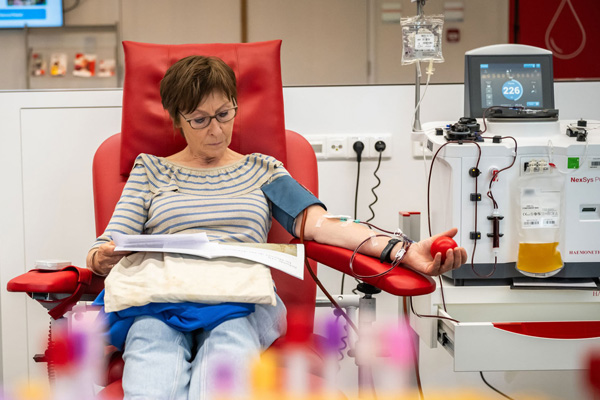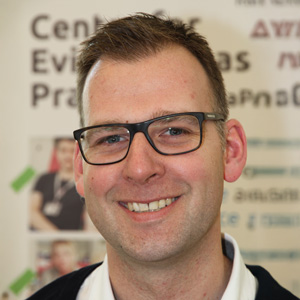Balancing donor safety and supply: The road to plasma self-sufficiency
Authors: Hans Van Remoortel, Tine D'aes
Centre for Evidence-Based Practice, Belgian Red Cross-Flanders, Mechelen, Belgium
Department of Public Health and Primary Care, Leuven Institute for Healthcare Policy, KU Leuven, Leuven, Belgium
Introduction
Plasma is an essential component in the production of life-saving medicines, such as treatments for infections, bleeding problems and immune disorders. Today, many European countries (including Belgium) rely heavily on plasma coming from the United States (US). To reduce this dependence, Belgian Red Cross-Flanders has set a clear goal: by 2029, we want to recruit 25,000 extra plasma donors in Belgium. Reaching this goal means not only encouraging more people to donate, but also ensuring that evidence-based policies on plasma collection and donor safety are in place. Plasma independence cannot be achieved by research alone. It requires scientists, policymakers, healthcare providers and the public to share knowledge openly and work together. This spirit of collaborative knowledge communication lies at the heart of our efforts to balance donor safety with Europe’s need for plasma self-sufficiency.
Background
Currently, around 80% of the plasma used in Europe for the production of plasma-derived medicinal products (PDMPs) originates from the US. American donors can give plasma up to twice a week (maximum 104 times per year), which has allowed the US to dominate global supply. By contrast, Belgian donors can give plasma only once every two weeks (maximum 24 times per year). This discrepancy creates a supply challenge and raises questions about donor health: can we safely increase donation frequency in Europe, or must we find other strategies to secure plasma independence?

The problem
Belgian Red Cross-Flanders aims to reduce reliance on foreign plasma, ensuring resilience in times of crisis. The COVID-19 pandemic highlighted the vulnerability of global plasma supply chains. At the same time, European demand for immunoglobulins and other PDMPs continues to rise sharply, due to aging populations and new therapeutic applications.
The search for answers
To inform policy and practice, the Centre for Evidence-Based Practice (CEBaP) of Belgian Red Cross-Flanders carried out a systematic review to explore how often plasma can be donated safely. This study was part of the EU-funded SUPPLY project, coordinated by the European Blood Alliance, which focuses on strengthening voluntary plasma collection across Europe. The SUPPLY project unites partners and stakeholders who contribute practical perspectives from across the plasma ecosystem, including donor care, clinical use of PDMPs and regulatory oversight. Their diverse perspectives ensure that emerging evidence is interpreted in the context of real-world experience and values—from donation centre logistics to bedside needs.
Results and recommendations
Our systematic review showed that very high frequency donation (twice per week) may result in a clinically relevant decrease in ferritin and bring IgG levels below the lower threshold of 6 g/L. The findings highlighted the importance of recruiting more donors to meet growing plasma needs, rather than relying on fewer donors to give more often.
Based on the results of the systematic review, partners of the SUPPLY consortium formulated three key recommendations:
- Limit plasma donations to a maximum of two per month until there is solid evidence that higher frequencies are safe;
- Monitor donors’ IgG levels regularly to prevent extremely low values (<6 g/L) that could harm health;
- Prioritise prospective studies to better understand the long-term health impact of different donation frequencies.
CEBaP presented the results of its systematic review and corresponding recommendations to the EDQM Blood Guide Working Group. This exchange enabled joint clarification of evidence gaps and helped shape specific guidance on donation frequency and IgG monitoring for the 22nd edition of the EDQM Blood Guide, an example of collaborative problem-solving rather than one-way evidence transfer.
To ensure the findings reached several relevant audiences, CEBaP also shared them through different channels, including the Belgian Red-Cross Flanders volunteers’ website and newsletter, internal communication for Belgian Red Cross-Flanders staff and the annual CEBaP newsletter. These platforms were used to translate scientific findings into plain language and encouraged feedback from staff, donors and the wider public.
Scientific data were further complemented with lived experiences. During Plasma Awareness Month (October 2025), a public campaign in Belgium highlighted why more plasma donations are needed, featuring testimonials from donors and patients. Donors described what motivates repeat donation and how scheduling and after-care influence their experience, while patients and clinicians explained how immunoglobulins affect daily life and treatment outcomes. These stories added depth to the communication strategy of Belgian Red Cross-Flanders, grounding our messages in the everyday experiences of those who donate and those who depend on PDMPs.
Challenges and lessons learned
One of the biggest challenges in plasma collection is finding the right balance between keeping donors healthy and meeting the growing need for PDMPs. Simply asking people to donate more often, like in the US (up to twice per week, i.e. 104 times per year), may put donor health at risk. At the same time, Belgium needs thousands of new donors to reduce dependence on foreign plasma, which means investing in awareness campaigns, flexible donation options and building trust through transparent communication. Science doesn’t yet have all the answers: there are still too few strong studies on how often plasma can be donated safely. Until Belgium becomes self-sufficient, it will also remain dependent on the global plasma market and US donor policies.
Next steps
To reach the ambitious goal of recruiting 25,000 new donors in Belgium by 2029 will require not only a strong recruitment drive, but also investment in high-quality research to better understand how often plasma can be donated safely. The results of such studies can feed into policy discussions at the European level, helping to shape fair and effective guidelines that balance donor safety with the need for supply. At the same time, building public trust is essential: clear communication about the risks, benefits and importance of plasma independence will motivate more people to roll up their sleeves and donate.
Key take-home messages
- Plasma independence is a strategic priority for Belgium.
- Evidence shows that very frequent plasma donation may compromise donor iron and immune status, so policies must prioritise safety.
- Recruitment and retention of voluntary donors is the most sustainable path to self-sufficiency.
- Evidence-based policy in action: a systematic review has directly shaped national strategy and contributed to debates on plasma donation in Europe.
- Engagement matters: insights from donors, clinicians, regulators and the public have helped shape communication, policy discussions and day-to-day decision-making.
References
Centre for Evidence-Based Practice (CEBaP). Evidence-based policy in action: CEBaP presents SUPPLY findings at EDQM conference 2025. Available from: https://www.cebap.org/news/evidence-based-policy-in-action-cebap-presents-supply-findings-at-edqm-conference/.
European Directorate for the Quality of Medicines & Healthcare (EDQM). Guide to the preparation, use and quality assurance of blood components 2025. Available from: https://www.edqm.eu/en/blood-guide.
D'aes T, van den Hurk K, Schroyens N, Mikkelsen S, Severijns P, De Buck E, et al. Balancing Donor Health and Plasma Collection: A Systematic Review of the Impact of Plasmapheresis Frequency. Transfus Med Rev. 2024;38(4):150851.
Rode Kruis Vlaanderen. 25.000 extra plasmdonoren gezocht tegen 2029 om versneld onafhankelijk te worden van buitenland 2025. Available from: https://www.rodekruis.be/nieuws-kalender/nieuws/25-000-extra-plasmadonoren-gezocht-tegen-2029-om-versneld-onafhankelijk-te-worden-van-buitenland/.
SUPPLY. SUPPLY project: Strengthening voluntary non-remunerated plasma collection capacity in Europe. Available from: https://supply-project.eu/.
To link to this article - DOI: https://doi.org/10.70253/UACN8450
Disclaimer
The views expressed in this World EBHC Day Blog, as well as any errors or omissions, are the sole responsibility of the author and do not represent the views of the World EBHC Day Steering Committee, Official Partners or Sponsors; nor does it imply endorsement by the aforementioned parties.
